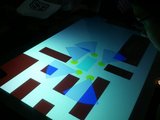
It's been so long since I've updated, I figure I'd better jam everything else in here and move on. Part 7 of my series covering my trip to the SDS will wrap up a parade of awesome that has included a plasma-guided rocket, aerodynamic bicycle farings, a life-size remote control and motion base, an SUV car wash, an autonomous oil-spill cleaning robot, and a couple of unusual EVs.
This time: multi-touch computer table! Wi-fi blood pressure monitor! Mine clearing robot car!! Frikken' BEER PONG TABLE... with frikken' LASERS!!! And EXCLAMATION POINTS!!!!
Sorry, I got carried away. Not so many exclamation points. But all that other stuff? Totes.
I won't be a tease: I offered you a multi-touch computer table, and here it is. The dark room makes it easy to see the screen, but tough to see the table itself.
There's a name for those cue cards, but I can't remember it. Cool stuff, though. And what does a programmer do with cool stuff? Writes a game!
Of course I spent some time talking with these guys. Their prototype was pretty expensive, but still less than Microsoft's table. Most of the expense is the short-throw projector; most projects use a mirror to give the projector more space, but they just pointed it straight up.
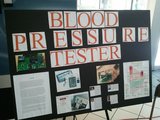

I have to admit, when they said "Wi-fi blood pressure monitor", I thought it was something that would continuously monitor you and graph your blood pressure on the screen. Maybe useful as a lie detector, or as a warning that you shouldn't be watching so many political ads.
No, it's just a regular blood pressure cuff, with a wi-fi dongle attached. It sends the data back to your computer. Their little control board has lots of safeties, so it could be used to automatically test a patient's BP at intervals and send the data directly to a nurse or doctor. Still very cool.

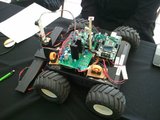
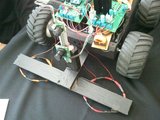
You know what's really neat about engineers? They're always thinking, "You know what would make this cool?" And they come up with stuff like this mine-detecting RC car.
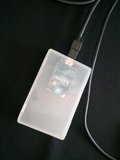
It drives itself! Well, the computer sends it commands via Wi-Fi, and it sends back status over the same link. You basically set it down, tell it where you want to go, and wait while it maps out a safe route.
The inducting loops on the front detect metal underground. Same as a metal detector. The car isn't really heavy enough to trigger most mines, but it can find them. If it does set off a mine (either through pressure or a trip-wire), at least you've only lost a remote-controlled car, not a soldier.
It also has switches built into the bumpers, so it can tell when there's an obstacle nearby. It uses an "a-star" algorithm to find its way to its destination.
The little dongle to the right is the same Wi-Fi chip used in the blood pressure monitor, the XBee Pro. I can think of all sorts of uses for that kind of technology, can't you?
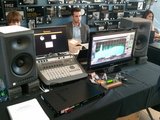
You deserve a little treat if you've actually been reading this far. Here's the neat bit I didn't tell you about in the title blurb: an iPad controlled equalizer!
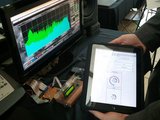
This is another case of collaboration, with electrical engineers and computer engineers working together. These guys made the whole place way too loud. And they could make it sound like a cathedral or a bar with a touch of their iPad screen.
My daughter now owns an iPad, and I'm still not all that impressed with it. However, these guys built a webserver into their equalizer, and it outputs HTML5 that will work on other platforms, too. In my opinion, that makes it even COOLER: a custom-built, wirelessly controlled, cross-platform equalizer with surround sound!
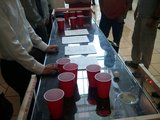
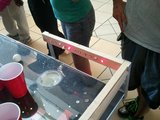
Melissa and I headed out to lunch, and when we got back most of the students had closed up and taken off. Therefore I don't have pictures of the RFID door lock, or the laser-guided self-tracking Nerf missile launcher, or any of the other cool stuff that was displayed... except this beer pong table.
You can clearly see the LEDs that tell you where to place the cups. Sensors under the plastic can detect whether the cups are correctly placed or not.
To the right, there's a PVC pipe recycling water, forming a drain for any liquid that might get spilled out of the cups.
And situated just barely above the cup rims on either end is a row of laser LEDs aligned to land on the detector on the other side. They're spaced just barely closer together than a ping-pong ball. When a ball lands in a cup, after being detected bouncing in the center, the computer can tell that someone's scored.
It keeps score, prevents disputes, and even plays a little "win" tune.
The SDS was a lot of fun, and even more so because I could bring one of my daughters. You can really see how engineers can bring the awesome, even before they graduate and get to work.
I can't wait until next year! I hope I can bring all three daughters!